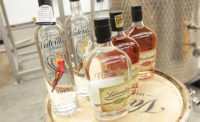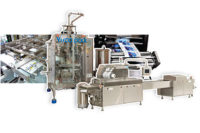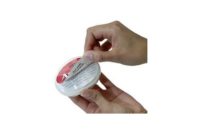Materials Technology: Labels
With labels, it's all about messaging
Labels speak volumes about your brand.








It’s no surprise that labels today are designed to do more than just stick around and inform buyers of what’s inside. They are designed to offer more opportunity for engagement, design elements, and also practical traits like light-blocking and water-resistant materials. Labels work hard to clearly speak your brand’s message, so what are they saying?
Functionality first
Clear-on-clear labels offer a sleek and clean look but can be problematic if required to withstand wet conditions. One such problem, known as the framing effect, occurs when moisture creeps under the label and causes an unsightly white haze along the label’s edges. Designed to eliminate this problem, HERMA (herma.com) has created the highly transparent label adhesive 62F. 62F is designed for beverage containers that need to withstand conditions in a cooler, where melted ice causes excessive moisture. When tested by immersing in water for 96 hours, the label adhesive did not show any signs of clouding. The adhesive is further characterized by high initial tack and very good resistance to oils and aqueous media.
The permanent UVA adhesive is designed specifically for challenging applications in the cosmetic, food and pharmaceutical industries. To ensure that the labels preserve their qualities for their entire life, the new grade offers excellent resistance to light, heat, water and aging. This film delivers good print quality with all the conventional printing techniques and produces visually appealing, glossy and highly transparent labels.
Another label works to block yet another element from destroying the package or its contents: light. Klöckner Pentaplast’s (kpfilms.com) Pentalabel® shrink film line has been expanded to include a new light blocking film, Pentalabel® eklipse™. This advanced product introduces maximum light blocking properties into the film process and satisfies a market need for films that are cost-effective, process efficient and improve light barrier characteristics. Pentalabel eklipse films also offer high performing shrink percentages for the best design possible while eliminating the need for high-barrier primary containers. This technology is ideal for food, health and beauty, home and garden, and household packaging. In addition, these new films offer other benefits to packagers – extended shelf life, off-taste reduction and vitamin protection (dairy products), reduced total package costs and color protection.
More engagement and more information
To get more engagement and fun into your label, one company from Italy delivers a solution that allows you to add a sticker insert between the bottle and the label. StickerIN, designed and developed by Sanfaustino Label (sanfaustinolabel.it), works well for the development of campaigns, games, entertainment and other promotional activities, especially for the beverage industry.
This innovation allows for the application of a removable, collectible, tradable sticker on the back side of a roll-fed label. It is an ideal solution for packagers who want to add more to their label, without using up valuable label surface space.
One company has created a different sort of label that is unique for many reasons. The K3® technology from Greiner Packaging (greiner-gpi.us) is a cardboard-plastic combination packaging for cups. The package features a cardboard label wrap that surrounds the package, but can be easily removed. It offers packagers the opportunity for more design and marketing messages, delivering immediate impact right off the shelf.
Here’s how it works: The cup consists of a cardboard-plastic combination. The inner cup is plastic but it is wrapped in a cardboard label that allows company’s more space to communicate with their customers. The outer cardboard label has a patented tear-open system that looks like a zipper and peels down the side of the cup, making it easy to separate the plastic and cardboard components. The cardboard surface provides another messaging platform to promote recipes, campaigns or just about anything else.
Other product benefits include reduced plastic content which contributes to lower CO2 emissions, and high strength and stability with the durable cardboard wrap. Additional functions such as windows in the cardboard wrap or special isolation effects can also be implemented according to individual specifications.
Recyclability is still a sought-after function of packaging, from the bottle itself to the label, CPGs and consumers appreciate this eco-friendly trait. Coca-Cola European Partners (CCEP) recently launched GLACÉAU Smartwater Sparkling, working with Constantia Flexibles (cflex.com) to create a pressure-sensitive label that fits with the brand’s values. It was a key priority for both CCEP and Constantia Flexibles that the labels be recyclable. Therefore, Constantia Flexibles gravure prints the labels on Avery Dennison’s (averydennison.com) recyclable CleanFlake™ material. This is the same material that they use on the original GLACÉAU Smartwater so rather than becoming waste, the labels will be retained and used to make new products. According to CCEP, the use of this material means that the business will recycle around 70 tonnes of waste each year and the carbon footprint of CCEP’s Morpeth factory will be reduced by approximately 80-100 tonnes of CO2 per year.
Additionally, the label is designed so that the water’s messaging can be seen through the bottle. Constantia Flexibles’ label uses special inks that allow the design to be seen on the front of the bottle, as well as on the back of the label, viewed through the water.
More benefits mean more “wow” factor and the more likely it is that consumers will remember your brand. Let labels be the soundboard of your package, proclaiming functionality, form and fun to deliver on your brand’s promise.
Looking for a reprint of this article?
From high-res PDFs to custom plaques, order your copy today!











